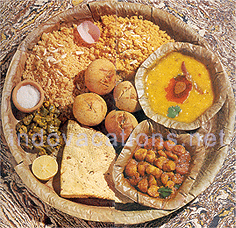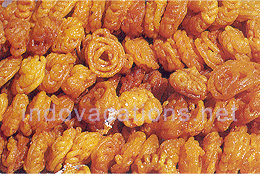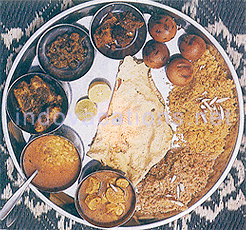
Welcome |
|
|
|
|
|
|
|
|
|
|
|
|
|
|
|
|
|
|
|
|
|
|
|
|
|
|
|
|
|
|
|
|
|
|
|
|
|
|
|
|
|
|
|
|
|
|
|
|
|
|
|
|
|
|
|
|
|
|
|
|
|
|
|
|
|
|
It is rightly said that the Indians live to eat
and the people of Rajasthan are no exception. The
cuisine of Rajasthan has its own place by the way
of traditional dishes and specialties. The cuisine
of Rajasthan is very rich and has a very unique flavour. The Rajasthani cooking was mainly
influenced by the war-like lifestyle of its
inhabitants and the availability of the
ingredients in the region. The food that could
last for several days and could be eaten without
heating was preferred. Scarcity of water and fresh
green vegetables have had their effect on the
cooking. In Jaisalmer, Barmer and Bikaner the
cooks used very minimum |
 |
|
water and preferred to
use milk, buttermilk and clarified butter. The milk,
buttermilk and yoghurt formed a part of the main diet, but
except those region which were accessed to the rice growing
areas, the rice-porridge, kheer, never became popular in
Rajasthan. But milk based sweets, barfis, still today are
known all over the country, and the sweet sellers all over
the country refer to themselves as Bikaneri sweet
specialists. The villager's diet mainly consists of the
bread of millets and gram flour, moth daal, a red chilli,
garlic chutney and raabri, a millet flour cooked in
buttermilk. |
|
|
|
|
Foreign Influences on the Cuisine of Rajasthan |
 |
There was variety in the meals of the royal families as
their finest cuisine was mainly influenced by the Mughals
and the Europeans. The Mughal cuisine was varied and lavish
and used the huge variety of ingredients, all of which was
harder to come by in the desert, even in the erstwhile
palaces. Delicacies like the kebabs and the curries were
introduced into the royal menu as a result of the influence
of the Mughals. Even though most of the dishes of
Rajasthan are vegetarian, Khud Khargosh happens to be an
example of a mouth-watering item prepared with the meat of
hare or a rabbit. The Mewar or Udaipur family, forced to
flee and hide in the rocky countryside by the
Mughals, devised the form of barbecue known as
Sooley. |
|
The
Kachchwaha family of Jaipur, created one of the
state’s finest delicacies, safed maas or white
meat. The dish is white in colour and consist of
mutton, and uses a curry of cashewnuts, almonds,
fresh coconut kernel paste, white pepper and poppy
seeds. The old retainers and chefs were used to
prepare the shepherd’s pie or French onion soup
so tasty that the princes when going on the world
trip for pleasure, would carry their own chefs to
cook their meals for them. The British also
influenced the manner in which the meal was eaten
at the table. Over the years, the peculiar
Anglo-Indian cuisine of the palaces too created a
distinctive cuisine. It also groomed the royals
into the Western style of dining habits. Earlier,
the food was served in silver and gold plates or
thaals and placed on low tables before which they
sat on silk cushions. The number of dishes in the
one meal ran into hundreds. Even in this, a strict
hierarchy was followed. The royals ate on gold,
the nobles on silver, and all others ate on the
bronze. Sometimes a thaal was shared between
siblings, or with kinsmen, to create the spirit of
comradeship so essential to kinship. |
|
|
|
|
Marwari Cuisine |
|
The Marwaris were more lavish with the inputs in their
kitchen. The Marwaris also used the same ingredients like
the Rajputs but their method of preparation of cuisine was
very rich and various spices and herbs like mango powder (amchur),
rai (mustard seeds) and heeng or asafetida were added to the
masala and cooked in fat. The Marwaris were great traders
and their sweet tooth was legendary. They were able to store
dry fruits such as almonds, pistachios, cashews, and poppy
seeds (khus) and also able to use them in their puddings. |
 |
|
Halwas, barfis and ladoos were part of the Marwari cuisine,
along with Til or sesame, which was used in both sweets and
in the main courses. In most of the festivals, the dessert
would consist of seera or halwa made of cooked wheat flour
in ghee or laapsi, a porridge made with desiccated grains of
wheat. Rice, a delicacy in Rajasthan, is also served as a
sweet with the addition of sugar, saffron and dried nuts and
raisins. Typically, all the members of the family would sit
together and the hot piping meals were served on the chokis
by the females of the house. The Marwaris eat two meals, in the morning and at
sundown. Both consist of a great variety of rotis and puris
puffed in piping hot oil. Their typical meal consists of
pishta-lonj served with a glass of milk laced with cream.
Then, puris fried in hot oil, made with both wheat flour and
with matar to provide a lovely green colour. With it,
tamatar-ki-sabji, a tomato curry, gatte-ka-saag, and
sangria-ker-ka-saag cooked in the clarified butter and
dahi-bhallas were eaten. This would be followed by
sooji-ka-halwa and a glass of lassi at the end of the meal. |
|
|
|
|
Regional
Specialties |
 |
The best known food which is found in the menu of the families
of Rajasthan is the combination of Daal, Baati
and Choorma, along with pickles and buttermilk. The daal consists of a lentil curry and baati is a
round ball of bread baked in a charcoal fire with clarified
butter concealed within and choorma is a sweet dish made with
bread bruised with jaggery or sugar and ghee. The baati could be
even made with wheat flour or millet or with a mix of maize and
wheat flour and choorma can also be made with the bread of
wheat, maize or millet, and combined with desiccated coconut,
khoya, or raisins and dry fruits. The choorma can also be
eaten in the various varieties. This famous cuisine is more
eaten in the picnics, during the monsoon season, when the hills
turn lush green. |
|
Each part of Rajasthan has its own traditional dishes and
specialties. Besides the spicy flavours, each region is also
known for its popular sweet. For example, Bikaner is known for
the bhujiya, papads, badis, lean mutton of the desert goat and
Rasogullas; Jodhpur is known for the Makhaniya
Lassi, mawa kachoris, hot green chillies laced with masala and
Ladoos;
Bharatpur is known for the milk sweets; Alwar is known for the
Mawa; Pushkar is known for the Malpuas; Udaipur is known for the
Dil Jani; Ajmer is known for the Sohan Halwa and Jaipur is known
for the Mishri Mawa and Ghevar. Ghevar is a Rajasthani delicacy
which is linked with the monsoon festival of Teej. It consists
of the round cakes of white flour over which sweetened syrup is
poured. Muslim food has also occupied a place in the overall
cuisine of the state, not just in Tonk and Loharu, but also in
Jaipur where the Muslim craftsmen celebrate Eid with great
quantities of Kababs and Pasandas, and with Sevaiyan. |
|
|
|
|
|
|
|